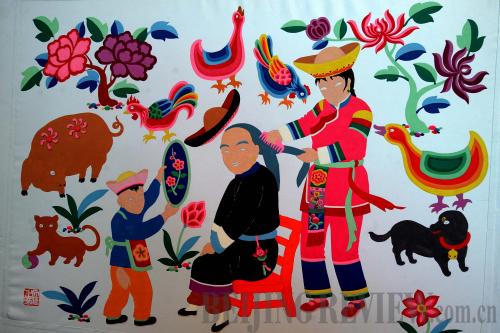|
 |
|
CUTTING IT: Qinghai's folk painting displays at the 2010 Shanghai World Expo (JUE GUO) |
Han Yimina, 26, is proud of her younger brother going to the university. But what she is more proud of is that she is paying for his studies with her own hands.
Born and raised in a farmer's family of Salar ethnic group in west China's Qinghai Province, Han and her brother were used to spending most of the year helping their parents work in the family's wheat fields. At that stage a much dreamed abut college education was unthinkable.
But things changed in 2007 when she got a handicraft-making job that guaranteed an income of at least 2,000 yuan ($300) per month, a sizeable sum by local standards and enough to make her brother's education dream come true.
Handicraft takes off
Han works eight hours a day in a handicraft gift company where she turns out folk painting items. Her monthly salary already surpasses her previous annual income working the fields.
"Usually a farmer [in my home village] only makes 1,500-2,000 yuan ($225-$300) per year from growing crops," Han told ChinAfrica.
"For those who go out to venture in big cities, lucky ones probably make 10,000 yuan ($1,500) a year, but as nongmingong (migrant farmer workers), many of them just hardly secure a stable income," she said.
More people, especially those from rural areas are turning to handicrafts as a source of income. According to data revealed by the Department of Culture of Qinghai Province, as of 2009, about 50,000 people are employed in the handicraft sector. That means one out of 100 persons in the local population are making their living from handicrafts.
However, handicraft has not always been as attractive an option as it is now.
Han Tahairi, who owns an art and handicraft products company in Xunhua Salar Autonomous County in east Qinghai, said it was the craft gift business which prospered in the last five years that made the sector an engine of rural employment.
"[The art craft making] used to be something restrained in families, especially passed between mothers and daughters," Han Tahairi explained to ChinAfrica. "It was hard to organize larger-scale production and nobody imagined that the handmade crafts could be turned into a huge business."
But as government mapped out its strategy to develop the region's cultural industry, the handicraft sector took off. Private investors were encouraged by multiple policy preferences. These include compensation for land use, subsidy for workers' training courses, and products order offers, among others.
|